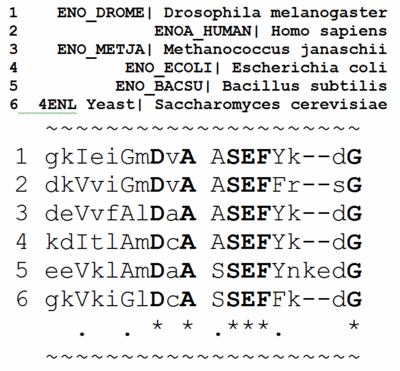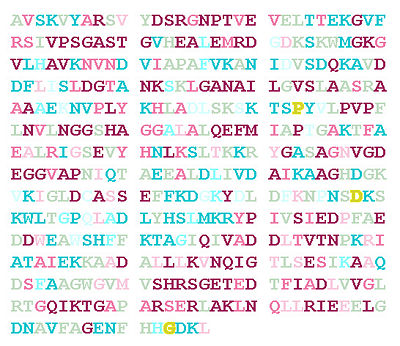Introduction to Evolutionary Conservation
From Proteopedia
(Difference between revisions)
| (13 intermediate revisions not shown.) | |||
| Line 104: | Line 104: | ||
<center>{{Template:ColorKey_ConSurf_NoGray}}</center> | <center>{{Template:ColorKey_ConSurf_NoGray}}</center> | ||
| + | ====Sequence Colored by Conservation==== | ||
When ConSurf's colors are applied to the 436 amino acids in the sequence of enolase (based on a multiple sequence alignment containing 150 sequences), this is the result: | When ConSurf's colors are applied to the 436 amino acids in the sequence of enolase (based on a multiple sequence alignment containing 150 sequences), this is the result: | ||
[[Image:4enl consurf150 sequence wb.jpg|400 px|left]] | [[Image:4enl consurf150 sequence wb.jpg|400 px|left]] | ||
{{Clear}} | {{Clear}} | ||
| - | Notice that the conserved residues are scattered around the sequence with no obvious pattern. However, when the same <scene name='Introduction_to_Evolutionary_Conservation/Enolase_with_consurf_colors/1'>colors are applied to the amino acids in the 3D structure</scene>, they form a conserved patch around the catalytic site (marked with a <span style="background:black; color:#00ff00;">''' zinc ion colored green '''</span>. | + | Notice that the conserved residues are scattered around the sequence with no obvious pattern. |
| + | |||
| + | ====3D Structure Colored by Conservation==== | ||
| + | However, when the same <scene name='Introduction_to_Evolutionary_Conservation/Enolase_with_consurf_colors/1'>colors are applied to the amino acids in the 3D structure</scene>, they form a conserved patch around the catalytic site (marked with a <span style="background:black; color:#00ff00;">''' zinc ion colored green '''</span>. | ||
*Show [http://firstglance.jmol.org/fg.htm?mol=http%3A//bioinformatics.org/firstglance/fgij/localPDBFiles/4ENLA_ConSurf_DB_pipe.pdb.gz conservation of enolase in FirstGlance in Jmol] ([[4enl]]). | *Show [http://firstglance.jmol.org/fg.htm?mol=http%3A//bioinformatics.org/firstglance/fgij/localPDBFiles/4ENLA_ConSurf_DB_pipe.pdb.gz conservation of enolase in FirstGlance in Jmol] ([[4enl]]). | ||
| Line 113: | Line 117: | ||
For instructions on how to identify conserved regions of a molecule of interest, and how to show them in Proteopedia (for example with green links), please see [[How to see conserved regions]]. | For instructions on how to identify conserved regions of a molecule of interest, and how to show them in Proteopedia (for example with green links), please see [[How to see conserved regions]]. | ||
| + | |||
| + | ==Expected vs. Unexpected Conservation== | ||
| + | Conservation is '''expected''' for those amino acids that support the 3D structure and functions of a protein. Common examples are listed in the table below. When there is no known structural or functional explanation for conservation of an amino acid, or a cluster of amino acids, the conservation is '''unexpected'''. Unexpected conservation may provide clues for discovering new functions or structural features, e.g. through functional analysis of mutants. | ||
| + | |||
| + | <table class="wikitable"><tr> | ||
| + | <th colspan="2"><center> | ||
| + | Expected Evolutionary Conservation | ||
| + | </center> | ||
| + | </th></tr><tr><th> | ||
| + | Amino Acids | ||
| + | </th><th> | ||
| + | Reason for Conservation | ||
| + | </th></tr><tr><td> | ||
| + | Gly, Pro in turns between helices or beta strands | ||
| + | </td><td> | ||
| + | Required for [[Evolutionary_Conservation#Conservation_for_Domain_Folding|protein domain folding]] | ||
| + | </td></tr><tr><td> | ||
| + | Charged amino acid (Lys, Arg, Asp, Glu) in a salt bridge | ||
| + | </td><td> | ||
| + | Required for [[Salt bridges|protein stability]] | ||
| + | </td></tr><tr><td> | ||
| + | Cys in a disulfide bond | ||
| + | </td><td> | ||
| + | Required for protein stability | ||
| + | </td></tr><tr><td> | ||
| + | N-terminal Met | ||
| + | </td><td> | ||
| + | Start codon for protein synthesis | ||
| + | </td></tr><tr><td> | ||
| + | Amino acids in a large cluster of highly-conserved residues | ||
| + | </td><td> | ||
| + | Required for protein function, e.g. catalytic or binding site | ||
| + | </td></tr></table> | ||
| + | |||
| + | [http://FirstGlance.Jmol.Org FirstGlance in Jmol] makes it easy to locate turns, salt bridges, disulfide bonds, or the N-teminus. In FirstGlance: | ||
| + | * Touch the conserved residue of interest to get its name and sequence number, e.g. Gly236 (in enolase 4enl). | ||
| + | * Use ''Find'' to put yellow halos around the residue of interest, e.g. enter ''Gly236'' in the ''Find'' slot. | ||
| + | ** Turns: Views tab, Secondary Structure. | ||
| + | ** Salt bridges: Tools tab, Salt Bridges. | ||
| + | ** Disulfide bonds: Tools tab, Disulfide Bonds. | ||
| + | ** N terminus: Views tab, N->C Rainbow. You may also wish to check ''Sequence Numbers'' and/or ''Residue Names'' near the bottom of the control panel (upper left panel). | ||
{{Clear}} | {{Clear}} | ||
| Line 121: | Line 166: | ||
*[[Evolutionary Conservation]] | *[[Evolutionary Conservation]] | ||
*[[ConSurfDB_vs._ConSurf]] | *[[ConSurfDB_vs._ConSurf]] | ||
| + | *[[ConSurf/Index]]: links to all Proteopedia pages about ConSurf and evolutionary conservation. | ||
==Notes and References== | ==Notes and References== | ||
Current revision
| |||||||||||
See Also
- How to see conserved regions
- Evolutionary Conservation
- ConSurfDB_vs._ConSurf
- ConSurf/Index: links to all Proteopedia pages about ConSurf and evolutionary conservation.
Notes and References
- ↑ MECP2 article in the National Library of Medicine's Genetic Home Reference
- ↑ Advantageous variability will be seen in these cases: 5hmg, 2vaa, 3hi6.




